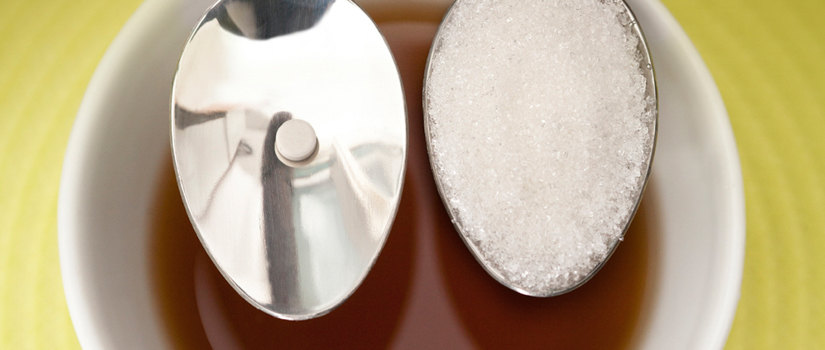Author
Margaret McCoy
Abstract
In America today there is great concern about obesity. In an attempt to balance a busy daily life with a healthy diet, consumers are now relying on artificial sweeteners to help them make a small step to a better lifestyle. With this notion in mind, there is the question of whether these artificial sweeteners are healthy. This paper discusses the effects of artificial sweeteners on weight and caloric compensation, and considers some hypotheses regarding the reasons for weight gain.
A review of literature led to the conclusion that artificial sweeteners can be 100-13,000 times sweeter than sucrose and that sucrose consumers who used artificial sweeteners daily could build a tolerance level towards them (Bellisle & Drewnowski, 2007). After a tolerance level is set, consumers would be at a greater risk to seek after sugar cravings relative to sugar itself that could lead them to obesity (Bellisle & Drewnowski, 2007). In addition, it was found in two studies by Swithers, Martin, Davidson (2010) that when rats were fed the artificial sweeteners saccharin and acesulfame potassium they gained more weight than rats that were fed glucose. Overall, it was found that consumers need to be cautious when consuming artificial sweeteners.
Submission
There are approximately 149.3 million Americans, aged 20 and older, who have a body mass index (BMI) of 25 or more (American Heart Association [AHA], 2011). BMI is calculated by dividing weight in kilograms by height in meters, which assists in determining obesity (Must, Dallal, & Dietz, 1991). The cost so far in 2011 for obesity is estimated at over $254 billion (AHA, 2011). The purpose of this research will attempt to answer the question: Is the replacement of sugar with artificial sweeteners an effective strategy for weight loss?
Role of Dopamine
According to Gearhardt, Corbin, and Brownwell (2009), implications involving dopamine is hypothesized to be a causative factor for obesity. Gearhardt et al. (2009) reported that out of 353 Yale undergraduates, 11% met the study’s criteria based on the requirements of the Yale Food Addiction Scale for food dependence. Students surveyed reported a persistent desire to cut back on food intake and consumed food in large amounts despite harmful consequences, all of which could be signs of food addiction. (Gearhardt et al., 2009). Wang et al. (2001) found that ten morbidly obese individuals, defined by the Centers of Disease Control and Prevention as having a BMI of 40 or more, weighing from 275-389.4 pounds at BMI range of 42-60, had lower levels of dopamine, a neurotransmitter that motivates us to eat, in the “reward” areas of their brains than did people who were of normal weight (Centers for Disease Control and Prevention [CDC], 2010).
The reason that obese people reach appetite satisfaction slower when they eat is because
their brains release less dopamine when eating (Liebman, 2012). As a result of the
lower level of reward perceived, obese people want more and more food because they
never reach a level of satisfaction. One food that is highly addictive is sugar.
Liebman (2012) gives the example that when animals eat sugar they overeat and eventually
become tolerant to sugar, thereby having to eat more to get a feeling of satisfaction.
It can be hypothesized that in order to break the cycle of dopamine and the sugar
addiction, switching from sugars to artificial sweeteners could result in obese people
losing weight from not chasing that “sugary high.”
Benefits of artificial sweeteners
Eating foods high in sugar content can lead to obesity and also insulin resistance,
both of which may be good reasons for a person to switch from sugar to artificial
sweeteners (Bachman, Baranowski, & Nicklas, 2006). Artificial sweeteners can be found
in many packaged foods and carbonated beverages, such as Diet Coke, Coke Zero, and
Pepsi Max. Artificial sweeteners are beneficial because they provide sweetness to
foods with fewer calories than natural sugars. Eating foods with fewer calories can
be something of value to those who are attempting to lose weight. However, although
artificial sweeteners have shown to be of some benefit because of their low caloric
value, researchers have found evidence showing potential worrisome effects of artificial
sweeteners on the body.
Negative consequences of artificial sweeteners
Choosing artificial sweeteners as a weight loss strategy may not be advantageous because of the possible dangerous side effects of artificial sweeteners. Whitehouse, Boullata, and McCauley (2008) cited a study that looked at the effects of aspartame, an artificial sweetener, on plasma and glucose levels during exercise in 14 men with type II diabetes. The aspartame breakfast used in the study raised glucose and insulin levels just as much as a baseline natural sugar sucrose meal did, thus showing that the use of aspartame would not be an effective way to decrease insulin and glucose if the user switched from sucrose to artificial sweeteners.
Studies on artificial sweeteners like saccharin have led to some concern over its safety. A study found by Whitehouse et al. (2008) states that exposing rats to saccharin during all stages of development ( i.e. in utero, lactation, and in food as an adult) demonstrated that rats had increased amounts of urinary bladder cancers when they ate diets containing 5 or 7.5% saccharin. As a result of the study’s conclusion, Whitehouse et al. (2008) states that the FDA put a ban on saccharin in 1977, but later removed the ban in 1991, while adding a warning label that described saccharin as a potential cancer causing agent. Whitehouse et al. (2008) notes that the warning label against saccharin was removed in 2000 when research showed the safety of the product.
Acesulfame-potassium is another artificial sweetener that has generated concerns over its potential effect. Whitehouse et al. (2008) states that it was approved in 1988 for use in beverages and in 2003 for general foods. Whitehouse et al. (2008) found a study that tested mice that had received doses of 60, 450, 1,100, and 2,250 mg/kg acesulfame-potassium and found that it produced genetic damage. Whitehouse et al. (2008) noted that the levels tested were above the acceptable daily intake (ADI). The ADI is defined “as an intake that individuals in a (sub) population may be exposed to daily over their lifetimes without appreciable health risk” (Whitehouse et al., 2008, p.257).
Exceeding the ADI of acesulfame-potassium is not difficult considering the large volumes
that are available, such as those that can be purchased at convenience stores. For
example, “Big Gulp” or “Biggie Size” sodas each hold 42 to 44 ounces of diet soda that contain
artificial sweeteners (Whitehouse et al., 2008). This shows that depending on the
amount of acesulfame-potassium ingested, negative health effects could ensue when
dosages ingested are above ADI.
From the preceding information I have formulated a hypothesis: if consumers lose
weight by replacing sugar with artificial sweeteners then consumers will lose weight
over time when put on a regiment of artificial sweeteners instead of sugar.
Methods
The research that I found was from literature reviews from USC-Columbia databases,
CINAHL and Academic Search Premier.
Results
The use of artificial sweeteners remains controversial. Some research has shown that they produce some weight loss when lower calorie foods and drinks were added to the diet. However, other research shows that artificial sweeteners cause weight gain.
A study done by Raben, Vasilaras, Moller, and Astrup (2002) showed that weight loss occurred with the use of artificial sweeteners. This ten week study split human participants into two groups, a sucrose group and an artificial sweetener group. The participants were supplemented with drinks and foods containing either sucrose or artificial sweeteners that they could ingest at liberty with a limitation only on the minimum amount that they could ingest. The participants were also allowed to continue their usual diet while using foods and drinks that contained sucrose or artificial sweeteners in an attempt to replicate what real life usage of these products would be like.
Raben et al. (2002) concluded that the human participants in the sucrose group gained 1.6 kilograms or 3.52 pounds, while the artificial sweetener group lost 1.0 kilogram, or 2.2 pounds. The researchers hypothesized that one primary reason that the sucrose group gained more weight than the artificial sweetener group is that 70% of sucrose was ingested from liquids, and were easier to over-consume than solid foods.
In contrast, a study found by Whitehouse et al. (2008) gives us some knowledge of why the use of artificial sweeteners may lead to obesity. The study found that the sweetness of artificial sweeteners can be as addictive as cocaine because in the act of eating sweet foods, the body stimulates dopamine in the ventral striatum, the area for reward and learning when sweet foods are eaten. Bellisle and Drewnowski (2007) state that artificial sweeteners are 100-13,000 times sweeter than sucrose. Acesulfame potassium is 100-200 times sweeter than the natural sugar sucrose, and neotame is up to 13,000 times sweeter than sucrose.
Three studies by Swithers, Martin, and Davidson (2010) displayed that people have difficulties losing weight while using artificial sweeteners. The first study by Swithers et al. (2010) concludes that rats that are fed the artificial sweetener saccharin gain more weight than rats that are fed glucose, a natural sugar. The second study showed that the saccharin fed rats had a weaker caloric compensation than rats fed with glucose. The third study found that other artificial sweeteners besides saccharin may cause weight gain in people.
The first study Swithers et al. (2010) conducted found that rats fed a saccharin diet gained more weight than the rats fed a glucose diet. The researchers in this group used the Pavlovian conditioning model that suggests that “tastes and other orosensory cues…evoke not only food intake, but a variety of hormonal, neural, and metabolic conditioned responses that prepare for … the efficient utilization of energy” (Swithers et al., 2010, p.56). Using this model, researchers proposed that if there was a reduction in the ability for tastes to predict caloric intake, then it would alter the effectiveness of the bodies’ response to energy regulation.
One group received 30 grams of plain unsweetened yogurt on some days and 30 grams of yogurt sweetened with 20% glucose on other days, while the other group received plain unsweetened yogurt on some days and yogurt sweetened with 0.3% saccharin on other days. The results showed at the end of five weeks that rats in the saccharin fed group did not signal an increase in the calories of the yogurt. In turn, the saccharin fed group gained more weight compared to the rats in the glucose fed group when sweet taste did provide a valid signal for calories. Figure 1 shows these results.
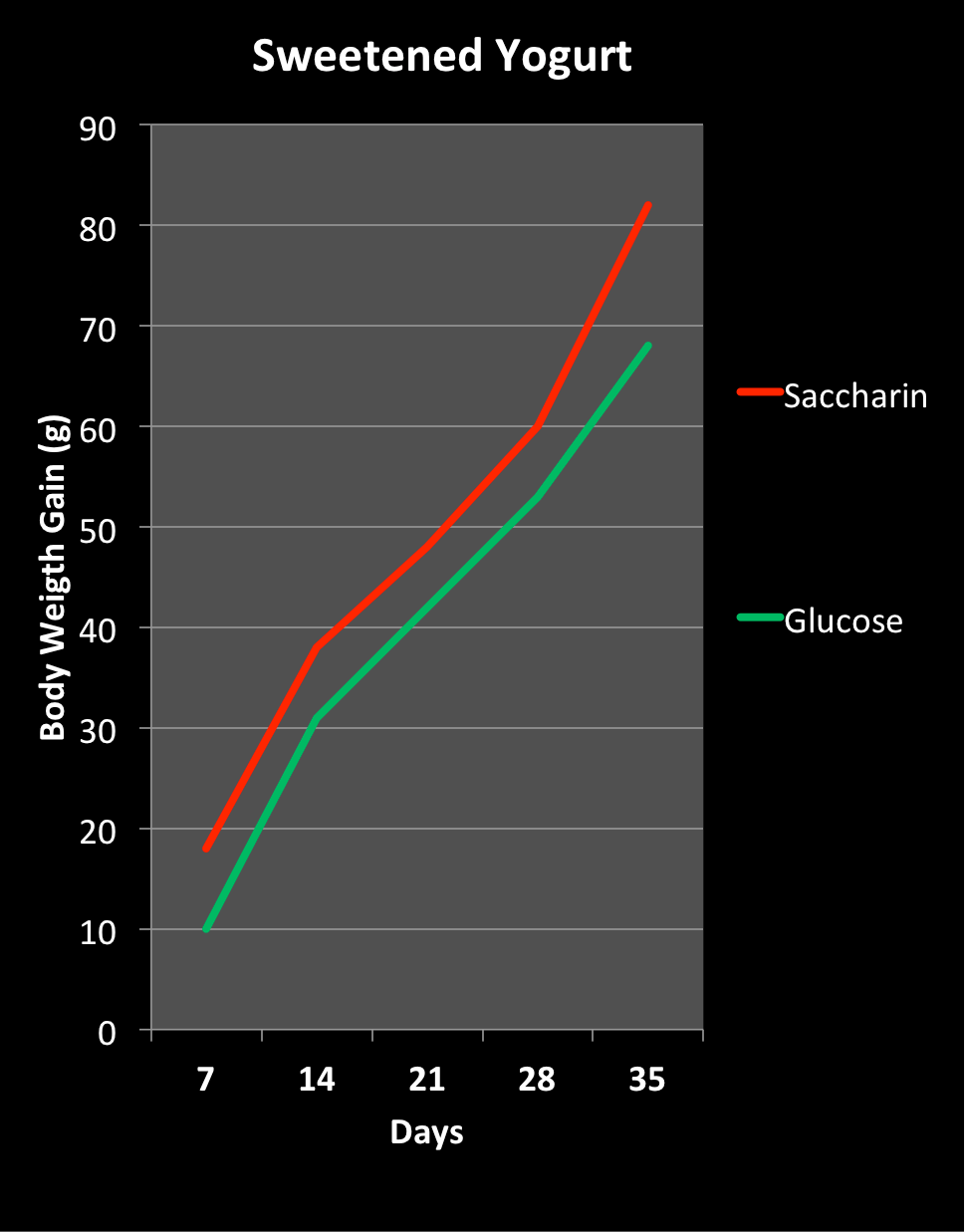
Figure 1: Body weight gain was greater in rats given yogurts with saccharin-sweetened diets compared to rats given yogurts that were glucose-sweetened.
The second study by Swithers et al. (2010) found that a saccharin diet fed rat group consumed more calories and had a weaker caloric compensation than the glucose diet fed rat group. Caloric compensation as defined by Swithers et al. (2010) is when “animals adjust for calories consumed on one occasion by reducing their caloric intake at subsequent opportunities to eat” (p.57). A weakened caloric compensation, where animals do not compensate their other meals after eating one meal, could result in excess calories accumulated. For example, a typical American Thanksgiving holiday lunch consists of turkey, dressing, beans, rice, gravy, macaroni and cheese, and desserts. Usually by the end of the meal, the eater would have ingested a high accumulated amount of calories. To compensate for such a large Thanksgiving lunch, the following meals would be at a lower calorie level to not add to the already high level of calories ingested. If a person had a weakened caloric compensation, after eating the large Thanksgiving lunch, they would continue to eat meals high in calories, which would accumulate to high calories eaten overall by the end of the day.
In the caloric compensation study of Swithers et al. (2010), rats in the glucose group received plain, unsweetened yogurt for seven of the fourteen days and 20% glucose for the remaining seven of the fourteen days. Rats in the saccharin group received plain, unsweetened yogurt for seven of the fourteen days and 0.3% saccharin for the remaining seven of the fourteen days. The rats in the glucose group were trained that sweet taste was a predictor for increased calories, where the saccharin group ingested sweet tastes which did not predict more calories. One test day the rats were given 5 grams of Chocolate Ensure for 30 minutes to see if they would eat more rat chow after the Chocolate Ensure meal and on another test day they were not given any Chocolate Ensure, just normal rat chow. The results showed that after given the Chocolate Ensure the glucose group consumed less rat chow, which was left available for the rats to consume after the Chocolate Ensure meal, therefore achieving a greater caloric compensation and less caloric intake when compared to the control of just normal rat chow (Swithers et al., 2010).
The saccharin group was less able to reduce their intake of rat chow to compensate
for the Chocolate Ensure meal and after given the Chocolate Ensure meal continued
to eat. Therefore, the saccharin group showed that they had a weaker caloric compensation.
Swithers et al. (2010) hypothesized that the reason for the weaker caloric compensation
was from the saccharin not signaling an increase in caloric content of the Chocolate
Ensure meal since the saccharin group were trained that sweet taste did not mean more
calories. Figure 2 shows these results.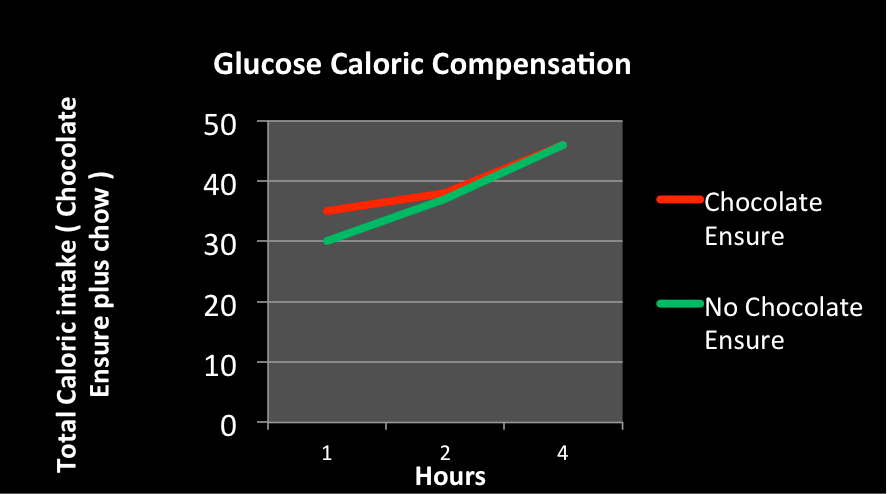
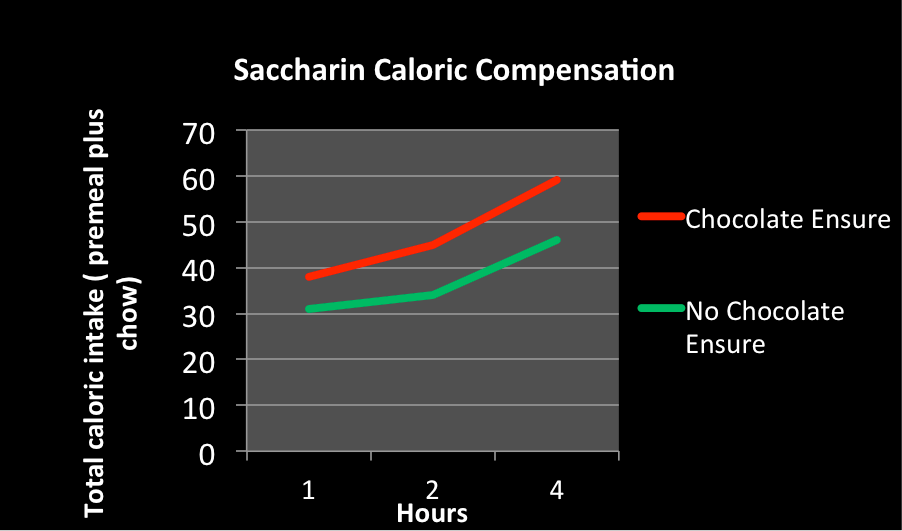
Figure 2: The saccharin-sweetened diet group of rats, who had been trained that a sweet taste did not mean more calories from the food item, had a weakened caloric compensation, and also a higher total caloric intake, after eating a Chocolate Ensure meal and afterwards eating rat chow. In comparison, the glucose-sweetened diet group had fewer calories eaten after the Chocolate Ensure meal in which sweet taste did predict increased calories.
The third study by Swithers et al. (2010) compared 0.3% acesulfame potassium, 0.3% saccharin, and 20% glucose. The results of the study showed that not only do artificial sweeteners, such as saccharin, influence weight gain, but other artificial sweeteners may make a person gain weight. Acesulfame potassium is labeled under such names as Sunsett, Sweet and Safe, and Sweet One and is a popular artificial sweetener that can be found in Coke Zero, Pepsi Max, and Minute Maid Light (Swithers et al., 2010). The study compared the three groups to see which group would have the most weight gain. The study had three groups of rats that were given 23-hour access to unflavored yogurt for 7 days then 7 days of access to yogurt sweetened with an artificial sweetener during which time the rats were trained that a sweet taste did not mean more calories from the food item. The results showed that the weight gain from the saccharin group and the acesulfame potassium group was similar and both had gained more weight than the glucose group. Figure 3 shows these results.
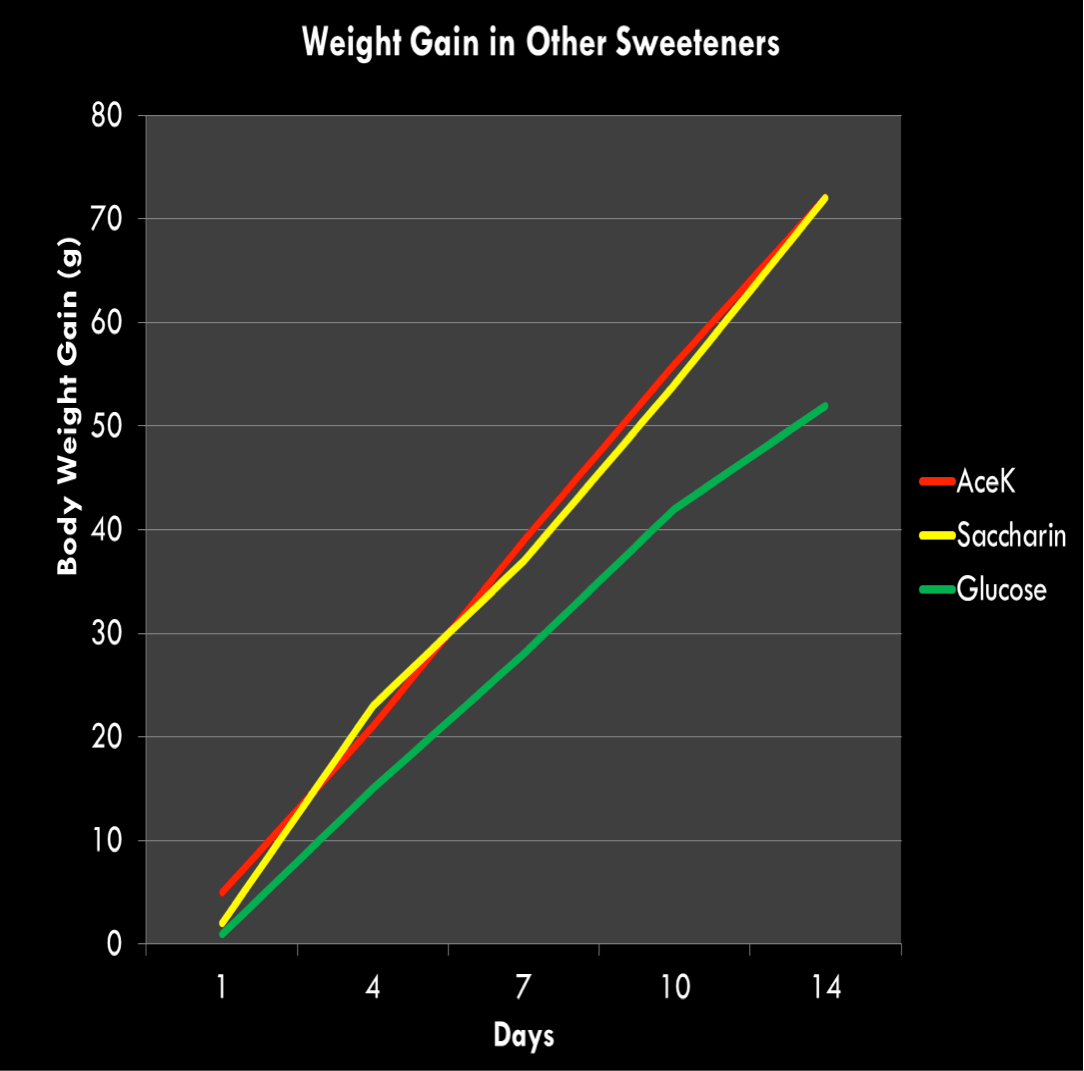
Figure 3: Body weight gain was greater in rats given yogurts with acesulfame potassium and saccharin compared to rats given yogurts with glucose.
Some hypotheses of why Americans are gaining weight were found during my literature review. Karras (2012) cited a study stating that artificial sweeteners can raise insulin levels and lower blood sugar, which may stimulate hunger and move existing calories into fat cells to be stored.
Another study found during my literature search showed that heat properties that the body produced during the ingestion of food related to the amount of calories being ingested (Swithers et al., 2010). The study done by Swithers et al.(2010) tested the amount of heat produced from a saccharin fed diet rat group compared to a glucose fed diet rat group. They hypothesized that the heat produced from the body after nutrients were ingested prepared the gastrointestinal tract for nutrient utilization and maintaining homeostasis. They believed that a larger amount of calories would produce more heat and a lower amount of calories would produce less heat.
Rats were given plain yogurt sweetened with glucose or saccharin for seven days and were given unsweetened yogurt for another seven days. A miniature radio-frequency transmitter was placed on each of the rats to measure core body temperature. The saccharin diet fed group of rats were trained that sweet flavor did not mean more caloric value, while the glucose diet fed group of rats were trained that sweet taste did mean more calories. The glucose sweetened yogurt had more caloric content than both the saccharin and the unsweetened yogurt, while the saccharin sweetened yogurt has the same caloric content as the unsweetened yogurt. Overall the glucose diet fed rats, when eating the glucose sweetened yogurt, had an increase in body temperature compared to when they ate unsweetened yogurt. Although the saccharin sweetened yogurt had the same caloric content as the unsweetened yogurt, the saccharin diet fed group produced less of an increase in body temperature when they ate the saccharin sweetened yogurt compared to when they ate unsweetened yogurt (Swithers et al., 2010).
When these two rat groups were given the same product, Chocolate Ensure, a high caloric
value food, to see how their body temperatures would react, the saccharin group had
a lower body temperature increase than the glucose group. The results suggest that
artificial sweeteners may disturb the physiological effects of how the body prepares
for incoming calories and calorie utilization in the body.
Conclusion
My research provides some answers to the question: Is the replacement of sugar with artificial sweeteners an effective strategy for weight loss? My former hypothesis that a consumer could lose weight through the use of artificial sweeteners was disproven by the information I found in my literature review. I found that artificial sweeteners could be 100-13,000 times sweeter than sucrose and if a consumer were to use them daily they could build a tolerance level towards them (Whitehouse et al., 2008). This refutes my hypothesis that artificial sweeteners will help a person to stop craving sugar and the high that it produces.
It leaves no doubt that once the tolerance level of sweetness from artificial sweeteners is built into a person’s appetite, the person continues to chase after the “sugar high”, which eventually may lead them to obesity (Bellisle & Drewnowski, 2007). This is seen in a study by Swithers et al. (2010) in which rats that were fed the artificial sweeteners saccharin and acesulfame potassium gained more weight than rats that were fed glucose. Another study done by Swithers et al. (2010) found evidence that the amount of heat produced from the body to prepare food for the gastrointestinal tract is disturbed when a body is conditioned to eating a regular diet of artificial sweeteners, which can interrupt the natural occurrence of calorie utilization by the body.
Overall, although there is evidence that artificial sweeteners produce negative effects
on the body, there is not enough conclusive evidence to show that artificial sweeteners
are beneficial or non-beneficial for a person in their entirety. In result of the
lack of definite findings, consumers should limit the use of artificial sweeteners
until more conclusive evidence is found.
Implications
Health care providers need to inform their patients of the ambiguity surrounding artificial
sweeteners and their use when starting a diet plan for weight control. When individuals
are planning to start dieting for weight loss, the nurse should include a plan of
how to decrease the amount of calories consumed daily and also implement a plan for
physical activity with the help of their primary health provider (Whitehouse et al.,
2008).
Future Research
In the future I plan to conduct a more extensive literature search to strengthen the conclusion of the studies that I found during my literature review. Additionally, since there are constantly new sweeteners being introduced to the market, I would research those sweeteners and see how they are metabolized and how they affect the body in longitudinal studies.
About the Author
 Margaret McCoy
Margaret McCoy
Following graduation, I plan to work a year as a registered nurse. Afterwards, I wish to spend two years in the Peace Corp and then later apply to the University of Colorado Denver for my master’s degree in the Family Nurse Practitioner program. I chose to research this topic after noticing how primary care providers encourage their diabetic clients to substitute sugar for artificial sweeteners as an intervention to improve the management of glucose levels. In result of doing research on this topic, I have become more conscious of artificial sweeteners in food and have encouraged others to be also. I would like to thank Dr. Kevin Elliott, Professor Iris Walliser, Dr. Linda Heraldo-Gacad, and Dr. Julia Ball. I would also like to thank the TRiO Ronald E. McNair Postbaccalaureate Achievement Program for supporting me through my research.
References
American Heart Association. (2011). Overweight and obesity. Retrieved from http://www.heart.org/idc/groups/heart-public/@wcm/@sop/@smd/documents/downloadable/ucm_319588.pdf
Bachman,C., Baranowski,T., & Nicklas,T.A. (2006). Is there an association between sweetened beverages and adiposity? Nutrition Reviews, 64(4), 153-171. doi: 10.1111/j.1753-4887.2006.tb00199.x
Bellisle, F. & Drewnowski, A. (2007). Intense sweeteners, energy intake and the control of body weight. European Journal of Clinical Nutrition, 61, 691-700. doi:10.1038/sj.ejcn.1602649
Centers of Disease Control. (2010). Morbid Obesity as a Risk Factor for Hospitalization and Death due to 2009 H1N1. Retrieved from http://www.cdc.gov/h1n1flu/in_the_news/obesity_qa.htm
Gearhardt, A., Corbin, W., & Brownell, K. (2009). Preliminary validation of the yale food addiction scale. Appetite, 52, 430-436. doi:10.1016/j.appet.2008.12.003
Karras, T. (2012). 7 reasons your diet’s not working. Prevention, 64(4), 28-36. Retrieved from http://www.prevention.com/
Liebman, B. (2012). Food and addiction: Can some foods hijack the brain. Nutrition Action Healthletter, 39(4), 3-7.Retrieved from http://www.cspinet.org/
Must, A., Dallal, G.E., & Dietz, W.H. (1991). Reference data for obesity: 85thand 95th percentiles of body mass index (wt/ht2) and triceps skinfold thickness. American Journal of Clinical Nutrition, 53(4), 839-846. Retrieved from http://ajcn.nutrition.org/
Raben, A., Vasilaras, T.H., Moller, A.C., & Astrup, A. (2002). Sucrose compared with artificial sweeteners: Different effects on ad libitum food intake and body weight after 10 wk of supplementation in overweight subjects. American Journal of Clinical Nutrition, 76 (4), 721-729. Retrieved from http://ajcn.nutrition.org/
Swithers, S.E., Martin, A.A., & Davidson, T.L. (2010). High-intensity sweeteners and energy balance. Physiology and Behavior, 100, 55-62. doi:10.1016j.physbeh.2009.12.021
Wang, G.J., Volkow, N.D., Logan, J., Pappas, N.R., Wong, C.T., Zhu, W., & Fowler, J.S. (2001). Brain dopamine and obesity. The Lancet, 35(9253), 354-357. Retrieved from http://www.thelancet.com
Whitehouse, C.R., Boullata, J., & McCauley, L.A. (2008). The potential toxicity of artificial sweeteners. American Association of Occupational Nurses, 56(6), 251-261. Retrieved from www.aaohn.org
